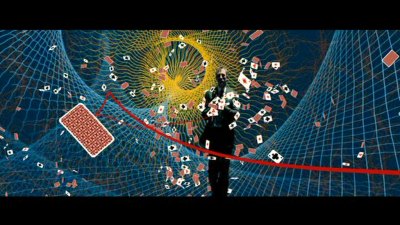
Now, in “Casino Royale,” the thuggish-looking British actor Daniel Craig (the blond Mossad agent in Steven Spielberg’s “Munich”) plays Bond as a humorless brute with a flat, classless Estuary English accent, and the critics (other than this one) are going wild.
Bond is supposed to be tall, dark, and handsome, but Craig is none of those, so there was much concern among fans. The filmmakers have dyed his hair light brown, however, so the audience’s usual unconscious color prejudice — in movies, blond is for leading ladies, not action heroes — is muted.
While Craig is certainly intense, his dry ice approach suits a film shorter than 144 minutes. “Casino Royale” is mediocre in execution and bloated in conception, wrapping the usual elephantine Bond movie mechanics around Fleming’s minimal plot (in the book, Bond doesn’t even get to kill anybody
Special thanks to “Carl Stromberg”
Click Here To Discuss This In Our Forum
James Bond is the most popular English fictional character since Sherlock Holmes, the hero of 23 movies raking in four billion dollars at the global box office. The essence of his screen appeal has been the paradox embodied in the medieval word “gentleman:” an individual of refined manners, educated in the arts of conversation, dress, and cuisine, whose profession is violence.
The English gentleman was the outcome of a project lasting a millennium and a half to mold the anarchic barbarian chieftains who conquered Dark Ages Europe into the upholders of civilization. Like the Japanese samurai, they were gentled by learning aristocratic culture, without, of course, demeaning themselves so low as to have to get a job that didn’t involve killing people.
Ian Fleming’s 1953 novel Casino Royale introduced a rather grim Bond. The charming but deadly gentleman Bond who had such an impact on popular culture was largely invented in 1962 by the director of “Dr. No,” Terence Young. A public school boy, Cambridge grad, twice-wounded WWII officer, wit, bon vivant, and ladies’ man, Young had everything except outstanding directing talent. He ended his career helming the seldom-seen epics “Inchon” for the Rev. Moon and “Long Days” for Col. Gaddafi.
What he did excel at, however, was teaching a young Scottish proletarian, a former milkman and coffin polisher named Sean Connery, how to act like Terence Young.
Ever since, the producers of the series, the Broccoli family, have periodically announced that they are junking the jokes and reverting to Fleming’s dark characterization of Bond. Even the flippant Roger Moore rebooted after the sci-fi hi-jinks of “Moonraker” in the lean “For Your Eyes Only” of 1981.
Now, in “Casino Royale,” the thuggish-looking British actor Daniel Craig (the blond Mossad agent in Steven Spielberg’s “Munich”) plays Bond as a humorless brute with a flat, classless Estuary English accent, and the critics (other than this one) are going wild.
Bond is supposed to be tall, dark, and handsome, but Craig is none of those, so there was much concern among fans. The filmmakers have dyed his hair light brown, however, so the audience’s usual unconscious color prejudice — in movies, blond is for leading ladies, not action heroes — is muted.
While Craig is certainly intense, his dry ice approach suits a film shorter than 144 minutes. “Casino Royale” is mediocre in execution and bloated in conception, wrapping the usual elephantine Bond movie mechanics around Fleming’s minimal plot (in the book, Bond doesn’t even get to kill anybody).
It might have been interesting to shoot “Casino Royale” as Fleming wrote it, as a short, modestly budgeted Marshall Plan-era period piece about a secret agent trying to prevent a French Communist union boss from striking it rich at the baccarat table so he can pay back the money he embezzled from his Soviet masters before they kill him. But there’d be no action, just a scene in which Bond gets tortured.
Instead, the screenwriters have added stunt-filled first and third acts that have only the most confusing relationship with the heart of the movie, in which Bond now outmaneuvers a terrorist banker at a high stakes poker game in Montenegro. (Isn’t the Texas Hold ‘Em fad like so 2005?)
We first meet Bond in Madagascar (which has to be the least strategically located country on Earth) where he’s chasing a villain around a skyscraper under construction, endlessly leaping from I-beam to I-beam like a Super Mario Brother. If you’re not a video game addict, this can get old pretty quick.
After an undermotivated excursion to the Bahamas, Bond is at the Miami airport wrestling with some random bad guy who is trying to crash a fuel truck into the giant Airbus 380, but this whole sequence was done better in “Road Warrior” a quarter of a century ago.
Then, it’s off to Montenegro for the big card game. Irritatingly, the movie cheats on its location shoots, with the Czech Republic, where practically every European segment is filmed these days (because quaint Prague wasn’t blown up in World War II), standing in for the newly independent beach country of Montenegro. And familiar, black-populated Bahamas weakly substitutes for exotic, Malaysian-colonized Madagascar.
One theme the film authentically preserves from the novel is its most distasteful, Fleming’s S&M obsession. Craig’s character suffers as much pain as the hero of a Mel Gibson movie. It’s the Passion of the Bond.
Special thanks to “Carl Stromberg”
Click Here To Discuss This In Our Forum



